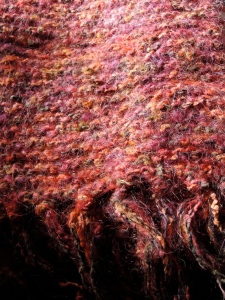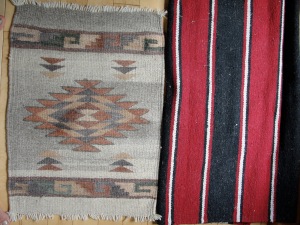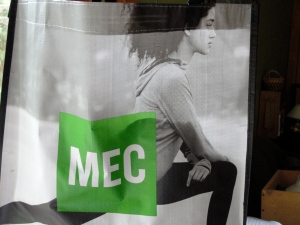Textile Structures
There are four types of textile structure:
Woven, Knitted, Felted and Pressed/ Rolled.
Please see following photos I took of items around my home that showcase these four structures.




Knitted textiles: The knitted structure has a long history of use and much of what we find in our homes and wardrobes use this structure. For items like outdoor clothing, knitted wear is easy to make, offers stretch, is easily folded and wrapped, and, because of its “3-D” structure of looping yarns, acts as an insulated barrier between the body and the weather. Knitted textiles are ideal for scarves, mittens, toques, sweaters and infant wear. Choosing which textile to knit will affect how comfortable and how easy the garment will be to clean and store. While the knitted structure does provide some measure of insulation, it does not provide much of a barrier to rain. Textiles knitted of acrylics get wet quickly and do not offer any protection. The same is generally true of cotton and wool, although if wool still contains an ample amount of lanolin from the sheep, it is amazing how warm and dry a person can be who may use a wool sweater for working in the rain. A case in point are the famous Cowichan Sweaters of the west coast which use a thick knitted wool yarn and a fairly loose structure, which seems to almost felt with use and is still popular as a “working garment” amongst First Nations and the general public.
Woven structures: I am guessing that the woven structure of textiles have the longest use in history and can be found everywhere in the world and in all manner of applications. The weaving of yarns in a warp and weft pattern can be done on the simplest to the most complex of frames and machines. The choosing of which textile fibres to weave will affect how easy the item will be to clean, how durable it will be, how insulative, and how flexible the final product will be. The weaving of fibres into mats and carpets offer a softer and warmer floor covering as well as protection of underlying surfaces. Finely designed and hand-dyed natural fibres woven into carpets capture the highest prices and will last years with proper care. Because of its open weave, it can allow dirt from shoes to filter through which will cause wear as the abrasive sand and dirt particles wear away the strands. It is recommended to not place carpets immediately at the threshold of a doorway, if the carpet is valuable.
Pressed structures: Pressed structures are relatively new and are made by pressing or rolling synthetic fibres into a durable, strong, cheap and versatile textiles. Re-usable pressed synthetic shopping bags are ubiquitous now and offer a handy bag for only 99 cents. While they are not waterproof, they do offer weather-resistant fabrics for multiple purposes. While many people are experimenting with up-cycling existing items, using this fabric for small items like change purses would not work as well as the fabric does not bend very well and is more suited to larger items where holding shape is more desired.
Felted structures: Felted structures are wonderful for using in a variety of ways. Felting inside of winter mitts make mittens warm no matter how cold Canada may get. Felting adds more depth to the fibres and increases the insulative capacities much more than having a fabric of knitted or woven structures. The yurts of Mongolia were made of felted wool and kept the people who used them warm inside their wind-proof homes. Felted wall and roof panels were ideal in a dry windy climate with little rain or insects and where mobility was essential. This style of housing has become more popular on the west coast but the felted wool would not work there at all; weatherized woven cotton has become the fabric of choice in the temperate rainforest climate!
Two useful sources (on-line) for understanding textile structures are as following:
1. The Fashion and Textile Museum of London has an exhibition on of the Mexican rebozo (shawl). I have a number of these that I bought in Mexico over many years and it used to be that a woman could be identified by which village she came from by the colour and pattern of her rebozo. I have visited this museum in the past and it has an amazing collection of textiles from all periods of history and from all over the world.
http://ftmlondon.org/ftm-exhibitions/made-in-mexico-the-rebozo-in-art-culture-fashion/
2. Kaffe Fassett Biography and Website. This site offers a comprehensive look at one of the world’s top designers in textiles, and the possibilities that fabric and colour offer to the imagination.
http://www.kaffefassett.com/Biography.html
Teaching Lesson: FST Grade 7
I would bring my collection of rebozos to my class and talk about their patterns, their multitudinous uses, and the changing in fibres as Mexico modernizes. Students could then research their own choice of ethnic shawl, including that of a great grandmother, and identify patterns, colours and specific usage. We would be sure to talk about embellishments!
http://www.kaffefassett.com/Biography.html
The idea of designing one’s rebozo is a grand idea! When I was a textile arts student, one of our projects was to design our family’s coat of arms. It was really fun to imagine the colours, figures (if any), and symbolism each contained.
Cathy
LikeLike
A further comment:
You are correct, weaving predates knitting although I saw 5000 year old knitted socks in the London Museum. The truth is that textiles don’t last and so we really don’t know. Knitted caps were part of carvings in ancient Greece and Egypt so this structure has been known for millenia as well. Also sprang – which I quite love. Very ancient as well.
Cathy
LikeLike
It is fascinating. Sprang- I’ll have to look that up; it sounds familiar… Remember the Ice Man they found in Switzerland? It was fascinating looking at the fibres that had survived. In northern BC a similar event occurred when the leading edge of an ice field melted and revealed a hunter’s body. I got to see the fibres under a microscope in the history museum in Victoria. 5000 year old knitted socks- imagine! If the knitter could even fathom the longevity of her effort… My company is arriving for breakfast and my little cabin looks like a honeymoon suite for them! Handmade quilt on the bed.
LikeLike
I don’t think the idea of imagining/ re-imagining our coat of arms ever gets tired or cliche. My own boys loved it in school and it still has great cache with students (and with adults). I also like the idea of the shawl as a pan-cultural construct- women have always wrapped something around our shoulders and designed it according to our traditions and imagination. (It’s different, but I was also very fascinated with fans- especially in historical Spanish culture where their use was a secret language and power was subtly executed).
LikeLike
I too love this idea of constructing coat of arms. I have used this as a beginning of the school year piece to gain a snapshot of insight and background of the students. I think it’s very cool how you transferred the idea to designing a rebozo. Such a great idea and has me thinking as to where I could take the coat of arms medley.
LikeLike
I am going to google cowichan sweaters now….Love hearing about your West Coast insights…. Sprang., It is complicated. You make a long warp, between 2 horizontal sticks, by wrapping the uncut yarn around and around up and down. Then you need 3 extra sticks. You thread one stick in and out in a certain way, then do it the opposite way with the second stick and once you alternate the third stick you take out the first and the twist is captured. I tried to do it once, and I only know about this because a man who ran a business in St. Catherines, Ontario tried to hire me to make sprang sashes. He sold supplies to historical encampment people, you know, who for a hobby dress up in civil war costumes and pretend to be back in time….. Well I had called him to order some pewter buttons and we got talking. British officers (especially in India) wore these springy looking sashes made of silk around their waists. Not only decorative, they turned into stretchy hammocks that would help to carry the officer off of the battlefield if they became injured. I was made to think of this again last week when taking my daughter to the Natural History Museum I actually saw one, in person, under glass for the first time. That business man said there were these 2 old ladies in England who used to make them and after they passed, literally no one in the World is producing these, so I was looking, once again, to make my fortune, but alas, it wasn’t easy for me to pick up this technique and I am sure no one would have bought the monstrosity I created-even if it was the last one in the World!
LikeLike
Wow, that’s fascinating about sprang weaving. It sounds like such an ancient craft and the tradition of carrying wounded men off of the battlefields speak to its strength. What a specialized contract to supply these to historical groups.
LikeLike